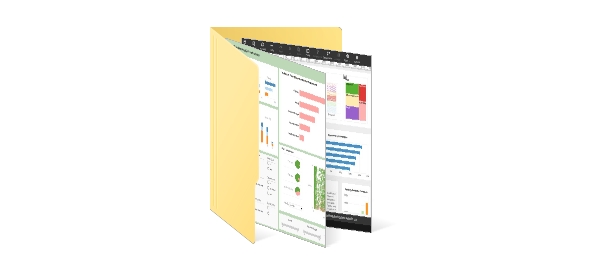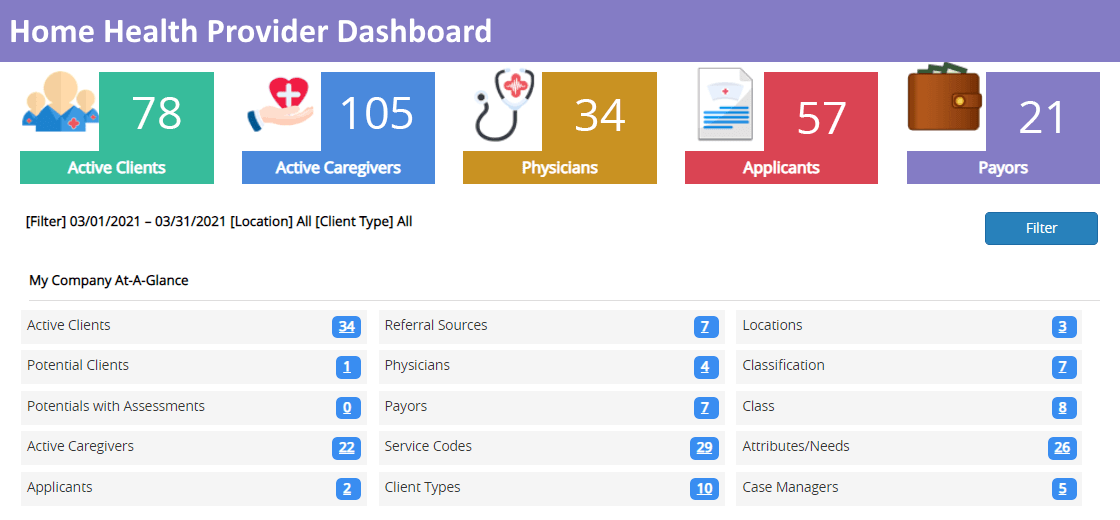What KPIs and Analytics Are Used on Home Health Provider Software Dashboards?
With its comprehensive approach to patient care management, home health provider software has completely transformed the healthcare sector.
KPIs and analytics on software dashboards provide providers real-time information, improving decision-making and care. We explore the essential KPIs and statistics used in home health provider software dashboards in this article.
| #1 Ranking: Read how InetSoft was rated #1 for user adoption in G2's user survey-based index | Read More |
Patient Admissions and Discharges
The first step in effective patient management is monitoring admissions and discharges. Dashboards created by home health providers using software provide up-to-date information on patients who are starting treatment and those who are finishing it. This KPI guarantees a smooth transition between patient care phases and helps providers use resources optimally.
Care Plan Compliance
Ensuring the faithfulness of a care plan is essential to providing high-quality medical treatment. Dashboards created by home health software provide information on how successfully caregivers and patients adhere to treatment programs. This KPI may be analyzed to help find areas that need improvement, enhance patient outcomes, and make sure that the treatment being provided complies with set guidelines.
Patient Satisfaction Metrics
One important metric for assessing the general quality of medical treatment is patient satisfaction. Dashboards for home health software use analytics to measure patient satisfaction via evaluations, comments, and surveys. With the use of this KPI, clinicians may maintain high patient satisfaction levels, swiftly resolve problems, and modify services to suit patient requirements.
Staff Productivity and Workload
Managing workers effectively is crucial to provide the best possible care for patients. Dashboards for home health provider software monitor staff productivity, including the quantity of visits, the amount of time spent with each patient, and the allocation of responsibility. Administrators are better equipped to decide on personnel numbers, training requirements, and resource allocation thanks to these insights.
Billing and Revenue Cycle Management
A vital component of the long-term viability of home health providers is their financial health. KPIs for billing and revenue cycle management are included in software dashboards, providing information on revenue trends, payment statuses, and claim processing. Keeping an eye on these measures guarantees prompt reimbursements, lowers revenue leakage, and improves the organization's overall financial stability.
Clinical Outcomes
Evaluating clinical outcomes is essential to determining if healthcare treatments are beneficial. Dashboards created by home health providers using software provide key performance indicators (KPIs) for patient health gains, rates of recovery, and treatment plan efficacy. Healthcare workers may improve clinical outcomes by adjusting their techniques with the help of these findings.
Medication Adherence
Maintaining good health and treating chronic illnesses depend on medication adherence. Medication adherence rates among patients are tracked by integrating KPIs into dashboards created by home health software. Through the monitoring of these data, healthcare practitioners may take appropriate action, resolve noncompliance, and enhance the overall health of their patients.
Emergency Response Times
Emergency reaction times are critical in the home healthcare context. Dashboards on software for home health providers provide data on emergency response, such as how long it takes for medical personnel to arrive to a patient's location. By keeping an eye on this KPI, you may improve patient safety and care quality by taking quick action in emergency circumstances.
 |
Learn about the top 10 features of embedded business intelligence. |
Telehealth Utilization
The emergence of telehealth has revolutionized the delivery of healthcare. KPIs that track how often telehealth services are used are included in dashboards for home health provider software. This information helps providers evaluate the efficacy of virtual care, pinpoint areas in need of development, and guarantee a smooth telehealth integration into their service portfolio.
Compliance with Regulatory Requirements
Maintaining home health professionals' ethical and legal integrity depends on their adherence to regulatory norms. KPIs are included into software dashboards to monitor regulatory compliance and make sure the company is adhering to the rules. Keeping an eye on these KPIs protects against legal problems and builds stakeholder and patient confidence.
Readmission Rates
In home healthcare, lowering hospital readmission rates is a major priority. Dashboards created by home health providers using software monitor readmission rates, which provides insight into how well post-discharge care is working. Healthcare practitioners may improve patient outcomes, save costs, and reduce needless readmissions by assessing this KPI and implementing focused interventions.
Caregiver Performance Metrics
In home healthcare, caregivers play a crucial role, and evaluating their work is essential. KPIs on patient interactions, caregiver effectiveness, and protocol adherence are included in software dashboards. By examining this data, providers can find high-achieving aides, provide focused training when it's required, and guarantee reliable, high-standard care delivery.
 |
Read the top 10 reasons for selecting InetSoft as your BI partner. |
Equipment Utilization
Effective home healthcare delivery depends on the efficient use of medical equipment. KPIs are included in dashboards for home health care software that track how often and how well medical equipment is used. This information helps clinicians distribute equipment as efficiently as possible, make sure that maintenance is done on time, and avoid having equipment malfunctions cause delays in patient care.
Geographic Patient Distribution
Comprehending the geographical dispersion of patients is essential for devising strategies and allocating resources. KPIs that show the concentration of patients in certain areas or neighborhoods are available via software dashboards. This data aids in the effective allocation of resources, the optimization of service delivery, and the targeting of outreach initiatives toward regions with greater healthcare needs.
Training and Certification Compliance
Keeping up a trained staff is essential to providing excellent in-home treatment. Software dashboards must provide KPIs for staff training and certification compliance. In addition to scheduling appropriate training sessions and making sure the staff is prepared for the always changing needs of patient care, providers may keep track of when credentials expire.
 |
View the gallery of examples of dashboards and visualizations. |
Time-to-Documentation
Ensuring regulatory compliance and keeping patient records need timely and accurate recordkeeping. Dashboards for home health providers' software provide key performance indicators (KPIs) that track how long it takes medical staff to finish paperwork duties. Keeping an eye on this indicator improves productivity, lessens administrative work, and raises the quality of patient care overall.
Patient Demographics
Comprehending the patient population's demographics is essential to customizing healthcare services to meet individual requirements. KPIs that provide information on patient demographics, such as age, gender, and medical history, are shown on software dashboards. This data assists clinicians in developing individualized treatment strategies and addressing the particular difficulties faced by various patient populations.
Employee Satisfaction
The quality of patient care has a direct bearing on how happy healthcare personnel are. Software dashboards for home health providers provide key performance indicators (KPIs) for staff satisfaction that are based on survey and evaluation results. By examining these indicators, healthcare professionals may resolve employee issues, create better work environments, and eventually improve the quality of patient care as a whole.

